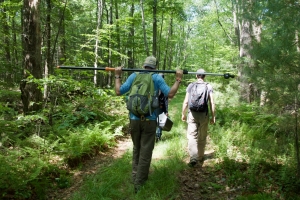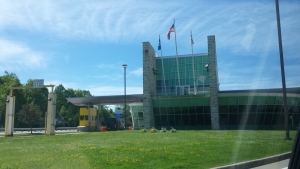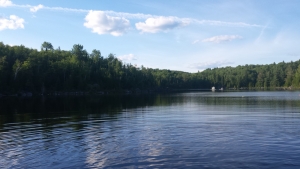You are here
Bienvenue à la Forêt Harvard
"You're bringing leaves and stem samples across the border?" the CPB (Customs and Border Patrol) Agent asks quizzically at our car.
How to respond in a short answer? "For ecological research" was the meek reply we settled on, and with a grunt the agent pulled us aside for further questioning.
This interaction occurred yesterday on my return trip from the University of Montreal Laurentides field station in Saint-Hippolyte about an hour and a half north of Montreal. For some further background information, I had spend the last week in Quebec collecting samples from roughly 160 individual plants for comparison with the Harvard Forest. I spend my days looking for branches with just the right amount of sunlight, hopefully with several years of growth making the stem thick. Not a bad way to spend a day, a week, or even a whole summer.
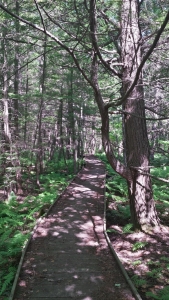 Let me backtrack a little though. The Harvard Forest, explained by Forrest in the previous blog post, is centrally located in the eastern North American temperate broadleaf forest. Broad maple trees, tall birches, and a scattering of ashes and aspens dominate the land. While the woodland sits peacefully larger agents, climate change, disease, and development, slowly grind their gears threatening to upend the natural processes. One way to study the possible outcomes and outlook of the forest is to compare similar biomes across a latitudinal gradient. In this way time is substituted for space; as the further north one travels generally the climate gets harsher. Seeing how the forest reacts to the change of climate is the broad overreaching idea to my research. This brings me back to my terse exchange on the USA-Canada border.
Let me backtrack a little though. The Harvard Forest, explained by Forrest in the previous blog post, is centrally located in the eastern North American temperate broadleaf forest. Broad maple trees, tall birches, and a scattering of ashes and aspens dominate the land. While the woodland sits peacefully larger agents, climate change, disease, and development, slowly grind their gears threatening to upend the natural processes. One way to study the possible outcomes and outlook of the forest is to compare similar biomes across a latitudinal gradient. In this way time is substituted for space; as the further north one travels generally the climate gets harsher. Seeing how the forest reacts to the change of climate is the broad overreaching idea to my research. This brings me back to my terse exchange on the USA-Canada border.
The Harvard Forest was picked as the southern terminus of the area of research. To observe the gradient of change, research sites were chosen at one-degree latitudinal demarcations in the White Mountains of New Hampshire, in Dartmouth's Second College grant in far northern New Hampshire, and Saint-Hippolyte in Canada. And now here I was in Quebec eating poutine and drinking maple syrup (not really).
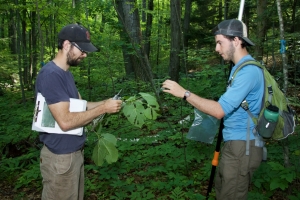 On the picture to the left, you can see my mentor, Dan Flynn, and I, in the field collecting samples. As described shortly above stems and leaves were collected for detailed laboratory analysis on morphology and tissue nutrient status. Upwards of 30 species were catalogued with at least six individuals from each sampled to see how their functional traits, such as stem specific density (a good indicator of drought resistance and growth rate) and height (correlated with fitness) change from mild New England to Quebec with its much harsher winters.
On the picture to the left, you can see my mentor, Dan Flynn, and I, in the field collecting samples. As described shortly above stems and leaves were collected for detailed laboratory analysis on morphology and tissue nutrient status. Upwards of 30 species were catalogued with at least six individuals from each sampled to see how their functional traits, such as stem specific density (a good indicator of drought resistance and growth rate) and height (correlated with fitness) change from mild New England to Quebec with its much harsher winters.
Just from my short trip to Quebec it was amazing to tangibly see the difference in the forests. While the paper birch is at the southern tip of its range at the Harvard Forest, and the Red Oak is nearing its northern limit in Saint-Hippolyte, the whole forest composition is different. As you can partly see in the photo to the right, the Canadian forest is much denser with the space between trees much reduced. Compared to the tall, graceful trees of the Harvard Forest, in Quebec everything is much smaller and knobbier.
Even though at meal times we were served French food at Saint-Hippolyte and hamburgers (and much more!) at the Harvard Forest, the field sites were remarkably similar. After finishing up with long days of fieldwork I cooled with quick swims in nearby lakes (currently Quebec's was a little more picturesque, but there is much exploring to be had in Petersham) and then evenings ushered in with Bananagrams and quiet chatter.
 Explain all that to a brusque border patrol agent in a sentence? No chance, but I am working on my 30 second elevator pitch. Cheers and happy trails!
Explain all that to a brusque border patrol agent in a sentence? No chance, but I am working on my 30 second elevator pitch. Cheers and happy trails!